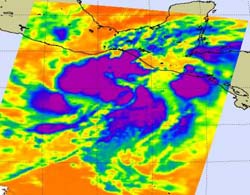NASA eyes low in eastern Pacific for tropical development

NASA\'s Aqua satellite infrared image on May 27 at 1:35 a.m. EDT showed System 90E with four areas of strong thunderstorms with very high, cold cloud tops (purple) around the center of circulation. Credit: NASA JPL, Ed Olsen<br>
AIRS, the Atmospheric Infrared Sounder instrument on Aqua, provides scientists with infrared satellite imagery. That imagery measures cloud top temperatures and sea surface temperatures. If the cloud tops in low pressure areas or tropical cyclones are colder than -63 degrees Fahrenheit, it indicates strong thunderstorms and strong convection (rapidly rising air that condenses and forms the thunderstorms that power tropical cyclones).
On May 27 at 1:35 a.m. EDT (05:35 UTC) AIRS imagery showed System 90E developing the trademark tropical cyclone approximately 205 nautical miles south of Salina Cruz, Mexico near 12.8 North and 94.5 West. AIRS infrared imagery indicated there were four areas of strong thunderstorms with very high, cold cloud tops around the center of circulation. Infrared satellite imagery indicates a slowly consolidating, broad low-level circulation center.
Winds in the area are estimated to be 20 to 25 knots (23-28 mph). System 90E is trudging west at 1 mph. The Joint Typhoon Warning Center noted that System 90E “is expected to continue consolidating over the next 24-36 hours. The potential for the development of a significant tropical cyclone within the next 24 hours is good.”
Media Contact
More Information:
http://www.nasa.govAll latest news from the category: Earth Sciences
Earth Sciences (also referred to as Geosciences), which deals with basic issues surrounding our planet, plays a vital role in the area of energy and raw materials supply.
Earth Sciences comprises subjects such as geology, geography, geological informatics, paleontology, mineralogy, petrography, crystallography, geophysics, geodesy, glaciology, cartography, photogrammetry, meteorology and seismology, early-warning systems, earthquake research and polar research.
Newest articles

Superradiant atoms could push the boundaries of how precisely time can be measured
Superradiant atoms can help us measure time more precisely than ever. In a new study, researchers from the University of Copenhagen present a new method for measuring the time interval,…

Ion thermoelectric conversion devices for near room temperature
The electrode sheet of the thermoelectric device consists of ionic hydrogel, which is sandwiched between the electrodes to form, and the Prussian blue on the electrode undergoes a redox reaction…

Zap Energy achieves 37-million-degree temperatures in a compact device
New publication reports record electron temperatures for a small-scale, sheared-flow-stabilized Z-pinch fusion device. In the nine decades since humans first produced fusion reactions, only a few fusion technologies have demonstrated…





















